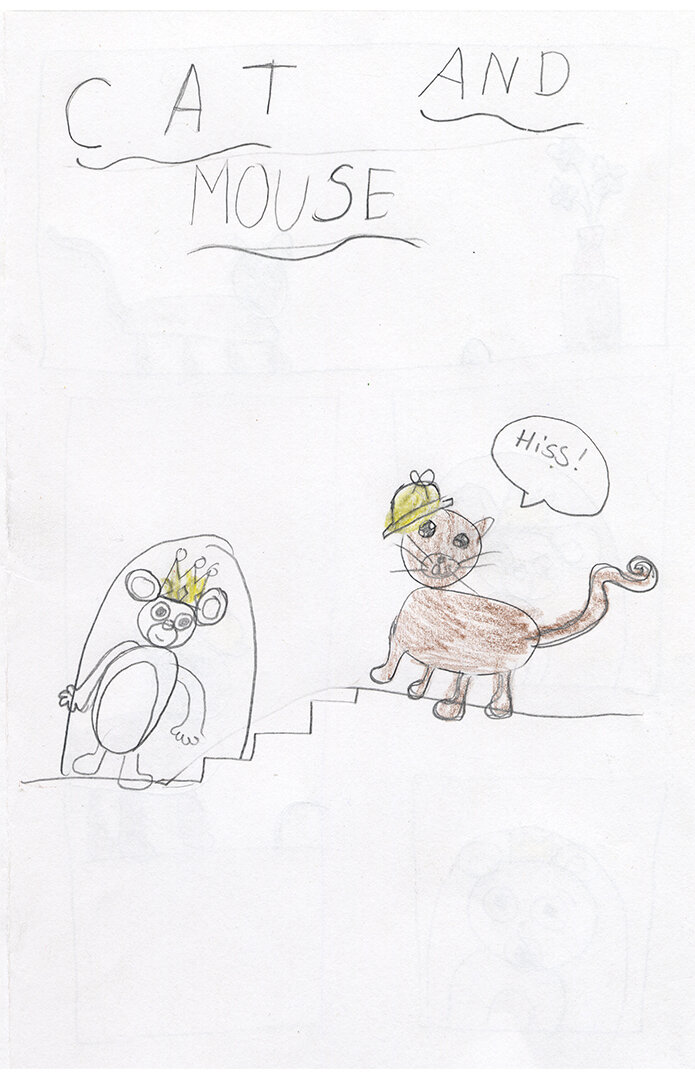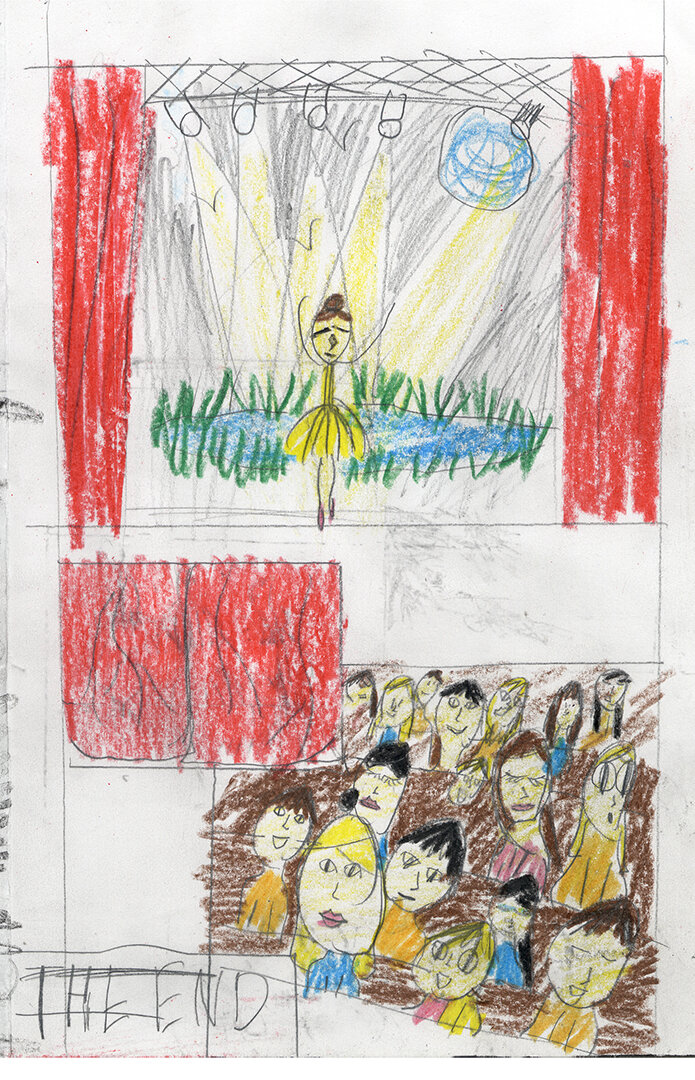Digital Showcase: Exploring Visual Arts II - Drawing Stories | Vitrine numérique : Exploration des arts visuels II – raconter par le dessin
Every year the Confederation Centre Art Gallery hosts three sessions of children’s art classes dedicated to exploring different mediums and developing visual literacy. Due to low COVID-19 numbers on Prince Edward Island, we are fortunate to be able to host these classes in person, with limited numbers and socially distanced work stations. Although students take their projects home to share with their families, typically the projects go unseen by the public. To celebrate their accomplishments, we are posting them online so you too can enjoy the creativity and imagination of these young artists.
In this class we completed two larger projects:
Project One: The Language of Comics
Over several classes, students were tasked with creating a short comic. It was to be a minimum of two pages with a front cover and had to tell a story of their own creation. The resulting comics ranged from tales about their interests in dance and sports, sword fights, planetary invasions, as well as fan-fiction from some of their favourite books and movie series.
While creating their comics, students were taught:
- Different ways of composing a panel such as the differences between a close-up and an establishing shot
- The differences between speech bubbles, thought bubbles and narrative/caption boxes
- Alternatives to the standard rectangle panel
Project Two: Animating Stories
Following the completion of their comics, students were asked to create a short, 12-frame animation that tied into the story of their comic. We used the example of flip-books as a way of relating the process of creating a longer animation to something students were more familiar with. From there they used a traditional animation bar to build their animation on tracing paper, which was then digitized into GIFs for easy viewing.
Students learned the following topics while creating their animation:
- The concept of frames per second in movies and animation
- How to create motion from a series of pictures
- Easy ways of creating motion with little to no technology
We hope you enjoy the work these students have made over the past few months and hope they inspire you to create your own stories with drawings.
Tous les ans, le Musée d’art du Centre de la Confédération offre trois sessions de cours d’art pour les enfants afin de leur faire découvrir diverses techniques et de développer leurs capacité d’interprétation visuelle. En raison du faible nombre de cas de COVID-19 à l’Île-du-Prince-Édouard, nous avons pu offrir trois sessions en présentiel, en limitant le nombre de participants et en maintenant la distance requise entre les stations. Les étudiants rapportent généralement leurs créations pour les montrer à leur famille et le public n’a généralement pas l’occasion de les voir. Pour célébrer leurs réalisations, nous les avons mises en ligne pour que vous puissiez admirer la créativité et l’imagination de ces jeunes artistes.
Dans ce cours, vous avons terminé deux gros projets :
Projet un : le langage de la bédé
Durant plusieurs classes, les étudiants ont créé une courte bédé. Elle devait faire au moins deux pages et comprendre une page couverture et raconter une histoire de leur cru. Les bédés portaient sur des histoires au sujet de leurs intérêts pour la danse et les sports, les combats è l’épée, les invasions planétaires ainsi que des fictions inspirées de leurs livres et séries de films préférés.
En créant leurs bédés, les étudiants ont appris :
- les différentes façons de composer des cases avec des gros plans ou des plans fixes
- les différences entre les bulles de parole, les bulles de pensée et les boîtes de narration/de légende
- les possibilités autres que le panneau rectangulaire classique.
Projet deux : histoires en animations
Après avoir terminé leurs bédés, les étudiants ont dû créer une courte animation de 12 images en relation avec l'histoire de leur bédé. Nous nous sommes servis de l'exemple des folioscopes pour relier le processus de création d'une animation plus longue à quelque chose de plus familier pour les eux. À partir de là, ils ont utilisé une barre d'animation traditionnelle pour créer leur animation sur du papier calque, qui a ensuite été traduite en GIF pour une visualisation facile.
En créant leurs animations, les étudiants ont appris :
- Le concept des images par seconde dans les films et les animations
- comment créer du mouvement à partir d’une série d’images
- un moyen facile de créer du mouvement avec peu ou pas de technologie
Nous espérons que vous apprécierez les travaux réalisés par ces étudiants au cours des derniers mois et qu'ils vous inspireront à mettre vos propres histoires en dessin.
Aidan McTague: “Cat and Mouse” | « chat et souris »
“I was making a comic about the game of cat and mouse. It’s a game I play a lot.”
« J’ai fait une bédé sur le jeu du chat et de la souris. Je joue beaucoup à ce jeu. »
Brynn Shipley: “Cloudpaw’s Journal” | « journal de Cloudpaw »
“There was a video online that my friend showed me and we watched it a million times and I kind of made the comic a little bit about that but I made it my own. The animation is of the character dancing.”
« Mon amie m’a montré une vidéo en ligne et nous l’avons regardée un million de fois times. J’ai créé une bédé qui porte un peu sur ça, mais à ma manière. L’animation montre le personnage qui danse. »
Frances Edwards: “The Box” | « la boîte »
“When I was younger I saw a picture of a woman who found a kid sleeping on a rock and I just thought about what I would do in that situation. So I created a story of a famous person finding a kid in a box and wanted to show how they cared for them. The animation was of the kid’s favorite toy.”
« Quand j’étais petite, j’ai vu une image d’une femme qui avait trouvé un enfant endormi sur un rocher et je me suis demandé ce que j’aurais fait dans cette situation. J’ai inventé une histoire au sujet d’une personne célèbre qui trouve un enfant dans une boîte et je voulais montrer comment elle allait s’en occuper. Mon animation parle du jouet préféré de l’enfant. »
Gabe Conroy, “Sword Fight” | « combat à l'épée »
“At school we were studying medieval times so I thought I would make my comic based on what I was learning.”
« À l’école, nous étudions l’époque médiévale alors j’ai pensé faire ma bédé sur ce que j’apprenais. »
Hang Nguyen: “Owl Lizzie” | « la chouette Lizzie »
“In the comic the owl goes to the North Pole. In the animation the owl went on holiday with her family and then goes back to her house and then goes out alone on a spring day. Then she goes to the North Pole to see her uncle and it ends in the magic river at the magic house which is made of feathers.”
« Dans la bédé, le hibou va au Pôle nord. Dans l’animation, le hibou part en vacances avec sa famille, puis revient chez elle, puis sort toute seule par une journée de printemps. Elle va ensuite au Pôle nord voir son oncle et aboutit dans une rivière magique dans une maison magique faite de plumes. »
Isabelle Lalonde: “The Dancer” | « la danseuse »
“I had a dance recital coming up, and the comic was about a professional dancer having a big performance. My small recital and dance classes were the inspiration for the comic and the animation was of her practicing.”
« Mon récital de danse était tout proche et ma bédé parle d’une danseuse professionnelle qui va avoir un gros spectacle. Mon petit récital et mes cours de danse m’ont inspirée pour ma bédé et l’animation porte sur sa pratique. »
Isla Lalonde: “The Ski Race” | « la course de ski »
“I chose to do my comic about someone who is learning how to be an Olympic skier because I like skiing. It’s kind of about me I guess because I want to be an Olympic skier. The animation is like a commercial for the comic.”
« J’ai fait une bédé sur quelqu’un qui apprend à devenir un skieur olympique parce que j’aime beaucoup skier. C’est un peu sur moi parce que je voudrais devenir une skieuse olympique. L’animation est une publicité pour la bédé. »
Seychelle De Sousa: “The Balloon” | « le ballon »
“It was going to be about a girl who has a bad day and keeps dropping things but it changed into a story about a girl who loses a balloon. The animation is the balloon floating in the air.”
« J’avais choisi de faire une bédé sur une fille qui passait une mauvaise journée et échappait tout, mais j’ai changé l’histoire pour celle d’une fille qui perd un ballon. Dans l’animation, le ballon flotte dans les airs. »
Yilia Zhang: “The Horror Dragon. Attack on Saturn” | « dragon d'horreur. l’attack de Saturne »
“The first thing in my mind that I thought of was dragons. So I just randomly chose that and made a story about them. The animation was inspired by a lot of the decorations around my house.”
« Les dragons sont la première chose à laquelle j’ai pensé. Alors j’ai choisi de faire l’histoire sur ça. Les décorations autour de ma maison m’ont inspirée pour mon animation. »
Xiaomei Jin: “A day in the life of… The girl I don’t really talk about!” | « Une journée dans la vie de... La fille donc je ne parle pas vraiment! »
“I made a comic a while ago about a girl who loves to eat cake and slams her face in the cake. And this comic happens before that and tells her story. It ends with her finding out that there was a comic made about her. The animation is of her eating cake.”
« J’ai fait une bédé sur une fille qui adore manger du gâteau et enfonce son visage dans le gâteau. La bédé commence avant ça et raconte son histoire. Elle se termine quand elle apprend que la bédé porte sur elle. Dans l’animation, on la voir manger son gâteau. »






















































